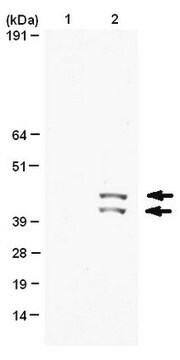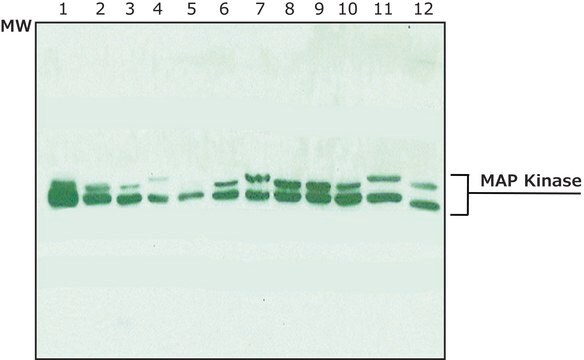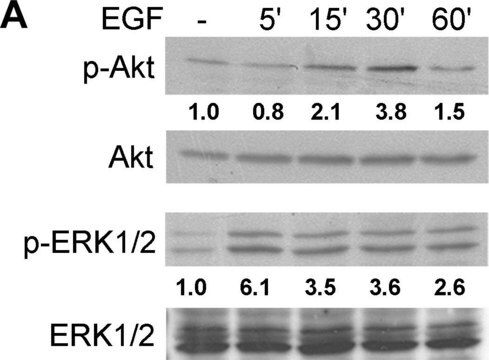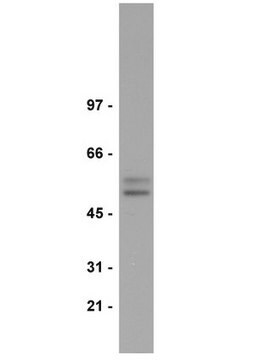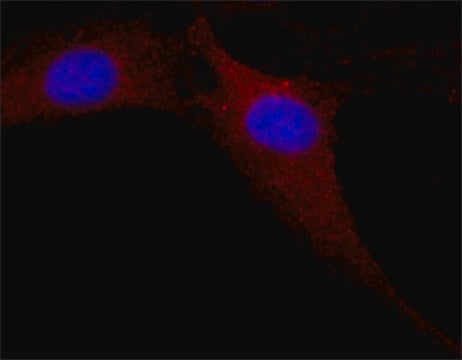Kluczowe dokumenty
M7683
Anti-phospho-MAP Kinase Kinase 1/2 (pSer217/221) antibody produced in rabbit
affinity isolated antibody, buffered aqueous glycerol solution
Synonim(y):
Anti-phospho-MEK 1/2 (pSer217/221)
About This Item
ICC
IHC (p)
IP
WB
immunocytochemistry: 1:1,000 using HeLa cells
immunohistochemistry (formalin-fixed, paraffin-embedded sections): 1:100 using tissue sections from human breast carcinoma
immunoprecipitation (IP): 1:50
western blot: 1:1,000 using serum-treated NIH-3T3 cells
Polecane produkty
pochodzenie biologiczne
rabbit
Poziom jakości
białko sprzężone
unconjugated
forma przeciwciała
affinity isolated antibody
rodzaj przeciwciała
primary antibodies
klon
polyclonal
Formularz
buffered aqueous glycerol solution
masa cząsteczkowa
antigen 45 kDa
reaktywność gatunkowa
human, rat, mouse
metody
flow cytometry: 1:50 using PMA treated human peripheral blood lymphocytes and Jurkat cells.
immunocytochemistry: 1:1,000 using HeLa cells
immunohistochemistry (formalin-fixed, paraffin-embedded sections): 1:100 using tissue sections from human breast carcinoma
immunoprecipitation (IP): 1:50
western blot: 1:1,000 using serum-treated NIH-3T3 cells
numer dostępu UniProt
Warunki transportu
wet ice
temp. przechowywania
−20°C
docelowa modyfikacja potranslacyjna
phosphorylation (pSer217/pSer221)
informacje o genach
human ... MAPK1(5594)
mouse ... Mapk1(26413)
rat ... Mapk1(116590)
Opis ogólny
The antibody specifically recognizes MEK1/2 (45 kDa) only when phosphorylated at Ser217 and Ser221. It reacts strongly with MEK1/2 phosphorylated only at Ser217, but less when phosphorylated only at Ser221. It shows not cross reaction with any other related family members including SEK.
Specyficzność
Immunogen
Zastosowanie
Postać fizyczna
Oświadczenie o zrzeczeniu się odpowiedzialności
Nie możesz znaleźć właściwego produktu?
Wypróbuj nasz Narzędzie selektora produktów.
Kod klasy składowania
10 - Combustible liquids
Temperatura zapłonu (°F)
Not applicable
Temperatura zapłonu (°C)
Not applicable
Wybierz jedną z najnowszych wersji:
Masz już ten produkt?
Dokumenty związane z niedawno zakupionymi produktami zostały zamieszczone w Bibliotece dokumentów.
Nasz zespół naukowców ma doświadczenie we wszystkich obszarach badań, w tym w naukach przyrodniczych, materiałoznawstwie, syntezie chemicznej, chromatografii, analityce i wielu innych dziedzinach.
Skontaktuj się z zespołem ds. pomocy technicznej